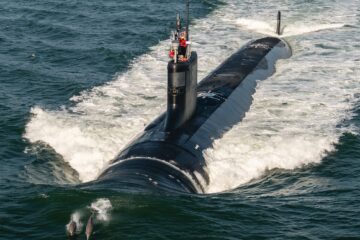The Russian Navy’s latest ‘Special Mission’ submarine, K-329 Belgorod, has put to sea for the first time. Open source intelligence seen by Naval News indicates that the submarine left Severodvinsk on June 25 2021. This represents the start of sea trials which are critical to the delivery of the new boat to the Russian Navy.
Although detailed specifications have not been revealed it is clear that Belgorod is the largest submarine to be built for 30 years. In fact the only submarine type which is larger is the Typhoon Class. Her enlarged Oscar-II class submarine hull is estimated to be 178 meters (584 feet) long and about 15 meters (49 feet) across. Her displacement will likely be significantly more than the ~19,000 tons of the Oscar-II class on which she is based. This is bigger in every respect than the largest Western submarine, the U.S. Navy’s Ohio Class.
The submarine was launched in April 23 2019 in Severodvinsk. Since then it has been moored to the quay there being fitted out and system tested. Russian media has reported tests of the new weapon system and also of the reactors. She had been expected to start trials in April, after the arctic ice had receded, but instead was taken back into the sheds. She remerged at the end of May and was identified undergoing degaussing on June 5 – 6. She has now finally sailed.
The ship left its berth for the first time on April 25. But instead of heading directly out to sea she was loaded into the floating dock and transferred back to the construction hall where she was built. By May 7 when another new submarine, Kazan, was being commissioned, preparations to bring her back out were visible.
Two Roles In One Submarine
Belgorod it’s intended purpose presents Western analysts with an enigma. She will combine two seemingly contradictory roles. The first is as a host submarine (read ‘mothership’) for deep diving nuclear powered midget submarines. These are capable of working on cables and other objects on the sea floor. The concern in NATO is that these could include the undersea internet cables connecting Western countries. This is termed a ‘special mission’ in navy parlance (which is full of euphemisms for covert activities).
The second role is one of nuclear strike and deterrence. For this she will be armed with six ‘2м39′ Poseidon torpedoes. These are a whole new category of weapon not fielded by any another navy. They have been described as ‘Intercontinental Nuclear-Powered Nuclear-Armed Autonomous Torpedoes’. At over 20 meters (65 feet) long they are in effect they are giant underwater drones with practically unlimited range and a nuclear warhead. And their expected performance (around 70 knots and 1,000 meters depth) mean that they cannot be countered with existing weapons.
These two roles are seen as contradictory because performing one may compromise the other. The nuclear deterrence role requires remaining hidden and out of harms’ way. While the ‘special mission’ may take her into potential harms way. And which role will be the primary one is also unclear.
For the Special Mission role, Belgorod is intended to host the Project 10831 Losharik submarine (AS-31). This suffered a serious accident on July 1 2019 however, just two months after Belgorod’s launch. A fire in the battery compartment killed 14 ‘hydronauts’ (the Russian term for the elite submarine crews who drive these deep-diving subs). Losharik is still undergoing repairs which may still take years to complete.
Possibly to mitigate the delays in returning Losharik to service, there have been reports that another deep-diving midget submarine is being adapted to fit Belgorod. AS-15 is a Project 1910 Kashalot class submarine (known as the Uniform class by NATO). She was laid down in 1983 and launched 30 years ago in 1991. But despite her age the titanium hull is likely to be in good condition so the idea of upgrading her is not far-fetched. But the Uniform class was never intended to be carried under a host submarine so the modifications would have to be very extensive. At this point these reports are unconfirmed and should be treated with caution.
The Poseidon weapon will also take a few years to be deployed, so it may take Belgorod several more years before she is truly operational. Recent Russian media reports suggested that the submarine will serve in the pacific, as opposed to the Arctic-based Northern Fleet. This seems counterintuitive as it would stretch the logistics for the deep diving submersibles which are based in the Northern Fleet. All the same she is a unique and impressive submarine which analysts will be following closely.






